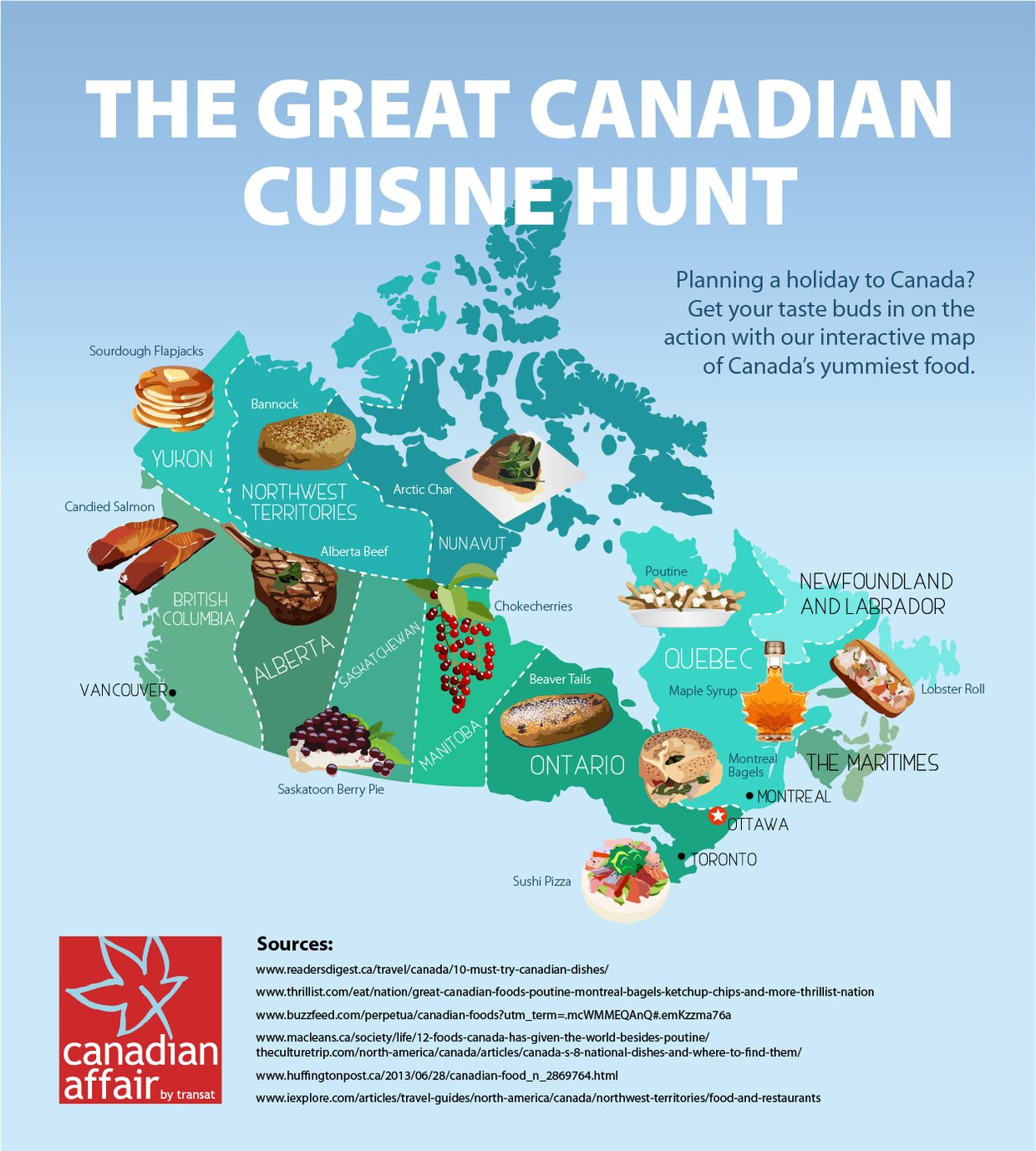Ever wondered what scrumptiously delicious food Canada has to offer? Explore the country with our cuisine map, where each image marks a new, tasty delight.

Deliciously Tempting Canadian Food
Canadians love food. But even though the maple leaf’s famous silhouette has pride of place on Canada’s flag, the nation boasts far more delicacies than just maple syrup. Rivers teeming with fresh fish branch into each of Canada’s far flung territories. Mind-blowing fusion foods grace every street corner in the buzzing city metropolises. Thanks to the lushness of its landscapes and the uniqueness of its peoples, Canadian food is as diverse as it is distinctive. And not to mention delicious.
If you’re planning your dream holiday to Canada, make sure your taste buds get a good share in the action with our map of where to find the best of Canadian food.
As Mystique from the popular food blog Chef Sous Chef comments, “"The Canadian food landscape is as genuine, diverse and proud as the people of this country. Each province's contribution to the food scene of Canada is a mosaic that when put together form a united and unique palate of flavours."
Famous Canadian Cuisine
Here is our run-down of the most famous of Canadian cuisine and where you can find some of the country’s more unusual regional specialities.
This lean, pork loin bacon is wet-cured for flavour and rolled in a crunchy crust.
Originally the crushed yellow pea coating was used to help extend the bacon’s shelf life, but today peameal bacon is covered in cornmeal for an irresistible bite.
It was William Davies, a bacon curer from Toronto, who was first credited with the food’s creation. He made it to sell to England, which was then experiencing a shortage in bacon.
Grilled in medium slices, the centre is left slightly rare, with a crispy exterior for a melt-in-the-mouth taste.
Toronto’s St. Lawrence Market is world-renowned for its peameal bacon sandwiches, particularly Carousel Bakery’s ‘World Famous Peameal Bacon Sandwiches’.
Regional Canadian delicacies
Around Canada, regions and provinces boast their very own speciality dishes, and some of these have even gained national and international acclaim
Tourtiere
Tourtiere, at its most simple, is a mouth-wateringly savoury meat pie
Though generally made of pork, onions and spices, this pie is a flexible and creative affair, leaving countless options open to experimental cooks. Whether it is bonus meats or flavours such as cinnamon and cloves, tourtière is a hearty dish that celebrates spontaneity. As long as it goes in a pie crust, it qualifies.
This dish is another traditional food of the Quebec region – it’s been associated with Saguenay since 1970, but the recipe for the pie dates back to 1600BC.
The historic Aux Anciens Canadiens is a fantastic place to try this dish for the first time.
Split Pea Soup
Did you know that yellow split pea soup originated in Quebec?
The dish, better known as Habitant soup, is made up of dried yellow split peas and ham bone or smoked ham hock, and is highly popular nationwide.
This dish is the perfect winter warmer for the colder months, but is also enjoyed as a light lunch year-round
Countless restaurants in Quebec City serve delicious split pea soups. Visit the up-market Chez Boulay Bistro and you are sure to find this soup in rotation.
Montreal smoked meat
A bit like pastrami, but with a noticeable pepper kick, Montreal-style smoked meat is one of the most popular dishes in the city.
This brisket-based, marinated meat is a labour of love, taking hours to prepare and slow-cook for the perfect texture and flavour.
If you’re a fan of smoky flavours and melt-in-the-mouth tenderness, you will love Montreal smoked meat.
To try the original product like the locals do, visit Schwartz's Montreal Hebrew Delicatessen, where for over eighty years the perfect smoked meat sandwiches have been created.
Montreal bagels
Montreal bagels are set apart from the American version by poaching in honey-infused water and cooking in a wood-burning oven for a sweeter taste and crispy texture.
Visit Fairmount Bagel to try this traditional breakfast food for yourself. Fairmount Bagels has produced famous baked goods since 1919, when it was the first bagel bakery in the city
Latest Articles

Why Visit Vancouver in Spring 2026?


01/01/2026
As the winter rain fades and the days grow longer, Vancouver undergoes a truly spectacular transformation. Spring isn't just a season here; it is a city-wide celebration of life, colour, and outdoor adventure!

Saskatchewan Highlights: Discover the Land of Living Skies


12/11/2025
Often called the 'Land of Living Skies', Saskatchewan offers some of Canada's most unique and spectacular holiday experiences.

Indigenous Experiences in Alberta


31/10/2025
Alberta's Indigenous communities have shaped this province for thousands of years, creating a cultural tapestry that continues to thrive today.

The Ultimate British Columbia Road Trip


17/10/2025
British Columbia offers some of Canada's most spectacular road trip routes, and this incredible 14-day journey through the province's diverse landscapes promises unforgettable memories.













